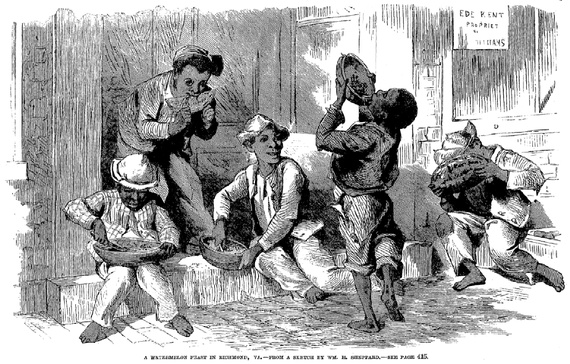There were many African grown crops that traveled along the slave ship with slaves. Most often foods such as okra, rice and kidney and lima beans accompanied them. The food was to ensure that the slaves were able to eat while traveling to their new way of life. There were also many other crops that traveled as well such as watermelon, yams, guinea melon, millet and sesame. Many of these crops today can still be found in many kitchens across America. The crops soon became not only eaten by Africans but by White American as well.
First brought to the New World during the transatlantic slave trade, black-eyed peas were a food used only for the slaves. They were first discovered in 1675, and quickly moved into other around the world before making its way into Florida, North Carolina and then Virginia by 1775. By the time of the American Revolution Black-eyed peas were firmly established in America and a part of the cuisine.
George Washington wrote a letter in 1791 explaining that food was rarely grown in Virginia. He later purchase 40 bushels of seeds for planting on his plantation. The peas went on to become one of the most popular food crops eaten in the Southern part of the United States. They were later called “cornfield peas,” by George Washington because of the early custom of planting them between the rows of field corn.
Okra was another food that arrived through the transatlantic slave trade in the 1600s. Often called gumbo or okra is extremely popular in New Orleans. Creole and African cooking cuisine came together to create some of the most popular and delicious stews and soups. The soups would consist of okra as the main ingredient along with vegetables and a thickening powder from sassafras leaves. An observer during the mid-1700s noted that Africans were extremely fond of the thickening powder. Okra was popular among the African women because they used it to produce abortion. They would lubricate the uterine passage with the slimy pods. In West Africa, women still use okra to produce abortion, utilizing the same method.
African cooks who prepared the meals in the “Main House” introduced their native foods to the planters. The planters eventually to the African culinary taste into the Main House. African cooks introduced deep fat frying, a cooking technique that originated from Africa. Today, people are still enjoying the taste and traditions of the Africans cooking ways. There are many different types of foods that are considered slave foods.
Slave Foods
Coffee
A much loved staple in many homes now. Comes from the word Kaffa, it is believed that the slaves from Ethiopia first introduced it.
Cala Cake
Cala is a known to be a sweet tasting rice cake. It was often served with morning café’ au lait. It was sold by black women in the French Quarter of New Orleans. In the state of Georgia the sweetened rice cake was called saraka.
Cowpeas/Black-eyed Peas
Cowpeas, or black-eyed peas became a well-known dish in southern parts of the United States by white and black people. The food traveled with slaves from their country on the ship.
Cush/Chushie
Cush is a sweet, fried cornmeal cake. It first appeared in American English in 1770. Gullah kush or kushkush. Related to Hausa via Arabic kusha.
FuFu
A delicious cake which was made from a mixture of cornmeal and flour and poured into hot boiling water. The Africans then made “hot cakes.” People who worked in the fields referred to it as ash cakes.
Grits
Slaves took hominy which is (Indian corn) and made grits. The dish was similar to eba which was prepared in Africa.
Guinea Corn
Guinea corn is also known as sorghum and millet. It was transported to the United States by Africans. The Guinea corn was used by Africans to make bread. It was also used to feed the fowl.
Gunger cake
Gunger cake is gingerbread tasting cake. The cake was originated in the Congos and was a cooked and prepared by enslaved Africans on plantations.
Hop’n johns
Hop’n johns is a well-known traditional West African dish of black-eyed peas and rice cooked together. It is still common in black southern cuisine.
Jambalaya
Jambalya, which was called Bantu tshimbolebole, in the African language is a dish of tender, cooked corn. African influenced dish that is quite similar to gumbo. The dish is still popular in many parts of New Orleans. It was brought to Louisiana by Africans from the Kongo.
Joll of rice
Style of cooking red rice brought to the American South by the Mande of West Africa.
Juba
Juba is a traditional slave food. Refers to the food that enslaved Africans working in the plantation house collected from the massa’s leftovers. The leftovers were referred to by Africans as juba, jibba, or jiba. There was no way to distinguish the bread from the vegetables or meat. It was often shared with the field workers.
Maluvu
Maluvu, or well-known as palm wine was produced throughout Africa from sap or jice collected from palm trees. African descendants continued to make it in Savannah, Georgia; in South Carolina the palmetto tree is the source. Materials called palm cabbage or palmetto cabbage is taken from the center of the tree and either cooked or fermented for wine.
Millet bread
Millet bread was an African food provided for cargoes by Africans who were enslaved.
Pone bread
Pone bread was mush that was made from cornmeal and often ate with the hands, the dish was noted as early as 1739.
Sesame
Sesame also known as “benne seed” in South Carolina was brought to the country by the West Africans to South Carolina. Slaves raised large crops of it. The seeds were used in soups and puddings.
Tania
Tania was a popular root plant in Sea Islands of Georgia and South Carolina. It had the taste of potatoes.
Watermelon
Watermelon spread from Sudan to Egypt during the second millennium. It is now a well-known fruit throughout the word. It was brought in the country during the slave trade.
References:
http://slaverebellion.org/index.php?page=crops-slave-cuisines





















10 Comments
http://slaverebellion.org/index.php?page=crops-slave-cuisines I had this site bookmarked and now I can’t find it any more please get this site back online I have bookmarked this one I love learning about the history of our people and no has the right to remove a site that demands we be recognized for our contributions to this country thank you for this site and the other one please get it back up soon black love, black unity, and black history.
Hi
I am doing a history project and need this answer in the next 48 hours please.
My question is that from where did you get all this information from. What was your source.
Please do respond to my question as sooon as possible
Thank you.
Hey There. I discovered your blog using msn. That is a really neatly written article.
I will make sure to bookmark it and return to learn extra of
your helpful information. Thanks for the post. I’ll definitely return.
Thanks for finally talking about >Black Then |
Cuisines Of Enslaved Africans: Foods That Traveled Along With The Slave Ships <Liked it!
Greetings! Very useful advice in this particular post!
It is the little changes that make the biggest changes.
Thanks a lot for sharing!
discount generic isotretinoin medicine in internet fedex Anchorage Acheter Amoxil En Ligne magasin levitra 20mg Compare Viagra Prices Uk
Cialis Without Perscription Amoxicillin Cure Vaginal Infection Viagara Overnight Propecia Side Effects Custom Propecia Zona Occipitale
I love it when people come together and share views. Great website, keep it up!
It’s awesome to go to see this web page and reading the views of all mates regarding this post, while
I am also zealous of getting knowledge.
Viagra Generico Pagamento Alla Consegna Cialis 10 Mg Bestellen Kamagra Canadian Pharmacy